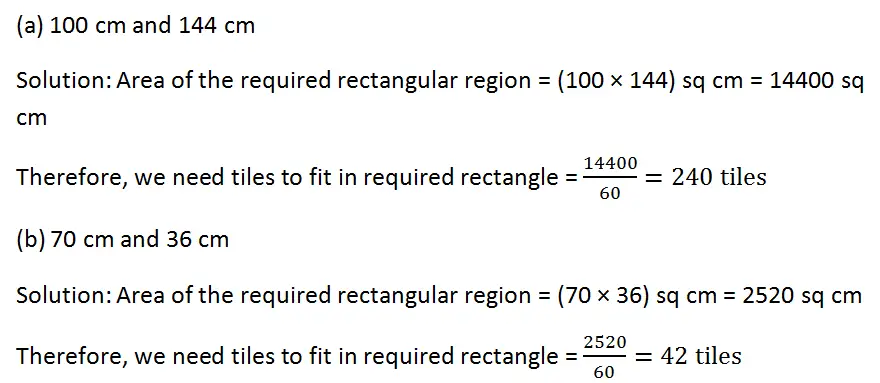NCERT Class 6 Mathematics Tenth Chapter Mensuration Exercise 10.3 Solution
EXERCISE 10.3
(1) Find the areas of the rectangles whose sides are:
(a) 3 cm and 4 cm
Solution: Area of rectangle = (3 × 4) sq cm = 12 sq cm
(b) 12 m and 21 m
Solution: Area of rectangle = (12 × 21) sq m = 252 sq m
(c) 2 km and 3 km
Solution: Area of rectangle = (2 × 3) sq km = 6 sq km
(d) 2 m and 70 cm
Solution: Here 70 cm = 0.7 m
Therefore area of rectangle = (2 × 0.7) sq m = 1.40 sq m
(2) Find the areas of the squares whose sides are:
(a) 10 cm
Solution: Area of square = (10 × 10) sq cm = 100 sq cm
(b) 14 cm
Solution: Area of square = (14 × 14) sq cm = 196 sq cm
(c) 5 m
Solution: Area of square = (5 × 5) sq m = 25 sq m
(3) The length and breadth of three rectangles are as given below:
(a) 9 m and 6 m
Solution: Area = (9 × 6) sq m = 54 sq m
(b) 17 m and 3 m
Solution: Area = (17 × 3) sq m = 51 sq m
(c) 4 m and 14 m
Solution: Area = (4 × 14) sq m = 56 sq m
Which one has the largest area and which one has the smallest?
(c) largest area and (b) smallest area.
(4) The area of a rectangular garden 50 m long is 300 sq m. Find the width of the garden.

(5) What is the cost of tiling a rectangular plot of land 500 m long and 200 m wide at the rate of Rs 8 per hundred sq m?
Solution: Area of the plot = (500 × 200) sq m = 10,0000 sq m.
Now the hundred sq m of the area = (100000 ÷ 100) = 1000
Therefore, the cost of tiling = Rs (1000 × 8) = Rs 8000.
(6) A table-top measures 2 m by 1 m 50 cm. What is its area in square metres?
Solution: Here 1 m 50 cm = 1.5 m
Therefore, the area of table-top = (2 × 1.5) sq m = 3 sq m.
(7) A room is 4 m long and 3 m 50 cm wide. How many square metres of carpet is needed to cover the floor of the room?
Solution: Here 3 m 50 cm = 3.5 m
Therefore the area of the room = (4 × 3.5) = 14 sq m.
(8) A floor is 5 m long and 4 m wide. A square carpet of sides 3 m is laid on the floor. Find the area of the floor that is not carpeted.
Solution: Area of the floor = (5 × 4) sq m = 20 sq m
Ans area of the square carpet = (3 × 3) 9 sq m
Therefore, the area of the floor which is not carpeted = (20 – 9) sq m = 11 sq m
(9) Five square flower beds each of sides 1 m are dug on a piece of land 5 m long and 4 m wide. What is the area of the remaining part of the land?
Solution: Area of the 5 square beds = 5 × (1 × 1) sq m = 5 sq m
And area of the land = (5 × 4) sq m = 20 sq m
Therefore the required area of the remaining part of the land = (20 – 5 ) sq m = 15 sq m
(10) By splitting the following figures into rectangles, find their areas (The measures are given in centimetres).

Solution: (a) (i) Area = (4 × 2) sq cm = 8 sq cm
(ii) Area = (6 × 1) sq cm = 6 sq cm
(iii) Area = (3 × 2) sq cm = 6 sq cm
(iv) Area = (4 × 2) sq cm = 8 sq cm
Therefore the total area of figure (a) = (8 + 6 + 6 + 8) sq cm = 28 sq cm
(b) (i) Area = (3 × 1) sq cm = 3 sq cm
(ii) Area = (3 × 1) sq cm = 3 sq cm
(iii) Area = ( 3 × 1) sq cm = 3 sq cm
Therefore tha total area of the figure (b) = (3 + 3 + 3) sq cm = 9 sq cm
(11) Split the following shapes into rectangles and find their areas. (The measures are given in centimetres)

Solution: (a) (i) Area of 1st rectangle = (12 × 2) = 24 sq cm
(ii) Area of 2nd rectangle = (8 × 2) = 16 sq cm
Total complete area of figure (a) = (24 + 16) = 40 sq cm
(b) Area of 1st rectangle = (21 × 7) = 147 sq cm
Area of 2nd rectangle = (7 × 7) = 49 sq cm
Area of 3rd rectangle = (7 × 7) = 49 sq cm
Total complete area of figure (b) = (147 + 49 + 49) = 245 sq cm
(c) Area of 1st rectangle = (5 × 1) = 5 sq cm
Area of 2nd rectangle = (4 × 1) = 4 sq cm
Total area of complete figure (c) = (5 + 4) sq cm = 9 sq cm
(12) How many tiles whose length and breadth are 12 cm and 5 cm respectively will be needed to fit in a rectangular region whose length and breadth are respectively:
Area of each tiles = (12 × 5) = 60 sq cm

Leave a Reply